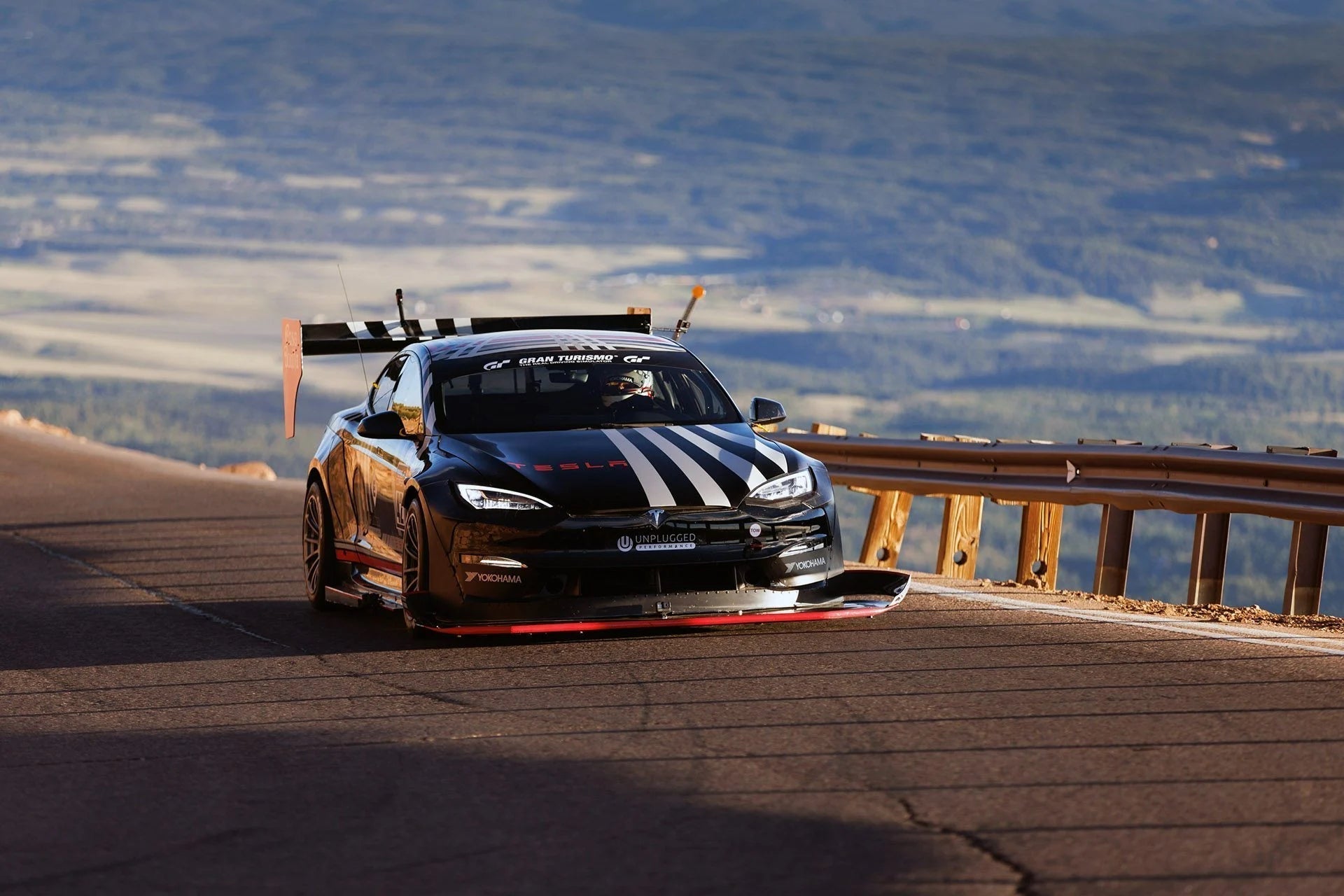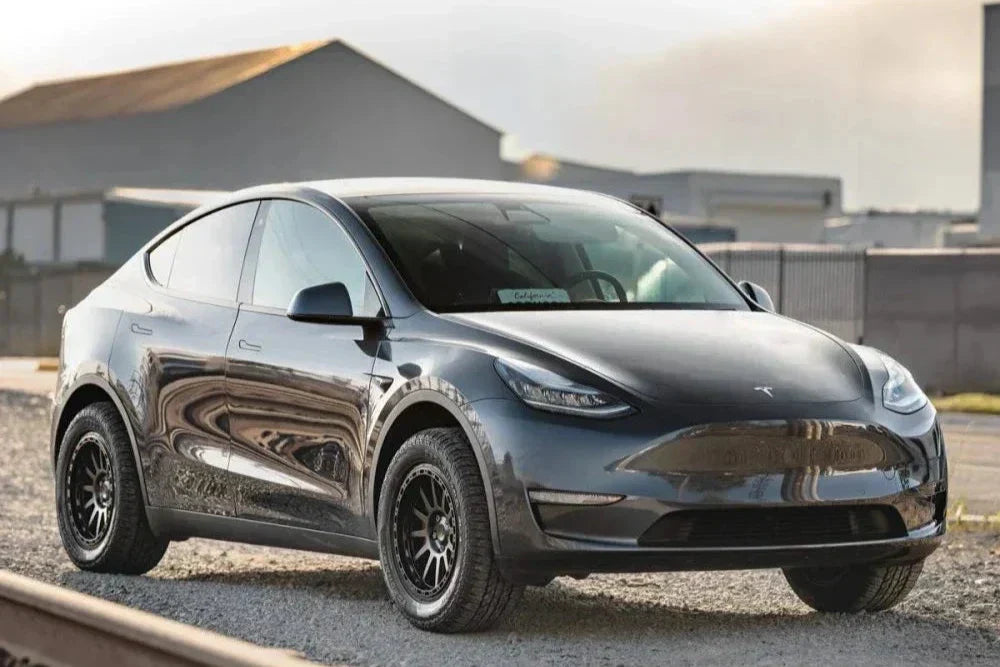Hearing a new noise from your Tesla, especially one that suggests something might be failing, can be a nerve-wracking experience.
But unfortunately, it’s all too common – and little wonder, with the immense torque, the additional loads from regen braking and considerable weight of the Model 3 or Y.
Meanwhile, as a mass-produced car, many of the Tesla’s suspension bushings and joints are manufactured down to a price. Meaning that accelerated wear of these parts is an inevitability as your mileage increases.
And this is where many of our customers start their ‘modifying journey’ with us – as a result of simply needing to replace failing parts on their Tesla (very typically worn-out suspension arms/bushes) . They realise the false-economy of choosing factory replacement arms that are certain to fail again in just the same way in future. Or worse (much worse….), the mistake of choosing cheap ‘Alibaba’ copy suspension parts that are of unknown quantity when it comes to durability and indeed safety.
But with the longevity that a Tesla drivetrain offers us, we’re seeing a bit of a new mindset in customers when it comes to car repairs.
More than was ever the case with ICE cars, it makes more and more sense than ever to invest in quality replacement parts on the chassis side of your Tesla and take a longer-term view of ownership as your mileage increases.
So in this short overview, we’ll walk you through some of the most common suspension noises that you might hear from your Tesla Model 3 or Model Y as they age. We’ll also give you insights into where these noises might be coming from, hopefully meaning that you can avoid costly and unnecessary repairs. After all, mechanics and dealerships often charge a premium for diagnosing noises and sometimes replace parts until the noise goes away - something we may be able to help you avoid!
Want to learn more about how the geometry and alignment work on the Model 3 and Model Y? Watch our video taking you through front and rear suspension elements here.
Take a look at this front suspension schematic drawing to familiarise yourself with the components under the front of your car:

1. Front Lower Lateral Fore Arms / Lateral Link
Common Noises: Crunching, Clunking
A clunking sound coming from beneath your Tesla is often related to the front lower lateral control arm. This is caused by wear on the bushings that allow the arm to move up and down when you go over bumps.
Sadly it’s all to common on these cars that over time, the rubber in the bushings can tear, causing lateral play and sloppy handling.
If the bushing wears out enough, the arm may even contact the subframe, leading to a crunching or clunking sound when braking or accelerating. Unfortunately, when these bushings inevitably need replacing, they require a full arm replacement, as the bushes are pressed-in during manufacture.
This is where our upgraded Front Lower Lateral Control Arms come in: they use uprated bushings and spherical bearings which offer vastly better durability and can help resolve these common wear issues once and for all. These replacement arms are popular for both their performance and cost-effectiveness benefits.

2. Front Lower Compliance (or Compression) Aft Arm
Common Noises: Crunching, Clunking
The front lower compliance arms, responsible for controlling the fore/aft movement of the front wheels, takes a lot of stress, especially when accelerating or braking hard.
Over time, the rubber bushings on this component can wear out, leading to noises when turning or going over bumps. A crunching sound, especially while turning at low speeds, or a creaking sound while stationary and turning the steering wheel, usually signals this issue.
Once again, Tesla only offers complete arm replacements. So rather than replace your arms with the same original versions, which are sure to fail again, this is the point at which many customers choose to upgrade to our Uprated Front Lower Compliance Arms.
We often find that these front lower compliance arms tend to fail at about the same mileage/time as the front lower lateral control arms do. After all, both sets of arms are doing a similar amount of work down there. Our advice is to get both sets of arms replaced at the same time if possible - it really will save you money on installation labour and the alignment afterwards to do it once, and do it right!
3. Front Upper Control Arm (FUCA)
Common Noises: Clunking, Creaking, Rattling
The front upper control arm (FUCA) is notorious for causing suspension noises in the Tesla Model 3 and Model Y. The issue typically arises from the ball joint, which can fail over time. This is unfortunate because the FUCA design itself is strong, lightweight, and cost-effective. However, water often gets into the seal around the ball joint, displacing the grease and leading to corrosion. This can result in a persistent clunking noise when driving over bumps or when steering.
A key indicator of this issue is a creaking sound when turning or going over bumps. Tesla often warranties these repairs, but some customers report having to replace the arms multiple times, as the replacements suffer from the same issue.
The only solution here is a full replacement of the arm- since the ball joints aren’t serviceable. We offer a full Adjustable Replacement FUCA set, using a robust, weather-resistant design. If the ball joint ever wears out again, it can be easily replaced in minutes with our simple bolt-on replacement.
Moving on the rear of the car, here's the layout under your car:

4. Rear Upper Front Traction Arms (“Upper Fore Link”)
Common Noises: Creaking, Clunking
The rear traction arm (and to a lesser extent, the rear trailing arm) is another area that can generate noise, particularly as – much like the front arms - the bushing deteriorates and separates from the arm. This failure is often accompanied by creaking or clunking noises from the rear of the car. Upon visual inspection, you may find that the bushing is either partially or completely separated from the stamped steel arm, allowing the arm to knock against the subframe. It’s actually quite easy to see in many cases.
Again, Tesla only offers a full arm replacement, but we offer Upgraded Traction Arms and Upgraded Trailing Arms that are designed to avoid these common failures resurfacing again.
As with the front arms, we recommend that it's probably worth replacing both sets of rear arms at the same time - as if one has failed, the others will likely be all-too-close behind.

5. Anti-Roll Bar Drop Links
Common Noises: Light Clunking / Rattling
Anti-Roll Bar end links often fail due to wear in the ball joint. This results in a clunking noise over bumps or road imperfections. Diagnosing this issue is simple - remove one end link at a time and drive the car. If the noise disappears, you’ve found the problem.
Once again, you can choose to replace with the Tesla replacements and wait for the next failure. Or choose our Adjustable Anti-Roll Bar Droplinks, especially when using aftermarket anti-roll bars and/or running at a higher or lower ride height than standard.

6. Anti-Roll Bar Bushings
Common Noises: Clunking, Crunching, Scratching
The anti-roll bars on these cars can sometimes rub against chassis components, creating scratching or clunking noises, particularly when turning. Additionally, some aftermarket polyurethane anti-roll bar bushings can expand and contract at different rates than the sway bar, causing scratching and crunching sounds when the vehicle goes over bumps.
For those in cold climates, temperatures below 0°C can cause the bushing to create these undesirable sounds. Whilst not pleasant, it’s not necessarily something to worry about until the weather warms up.
7. Shock Absorbers / Coilovers
Common Noises: Clunking, Rattling, Pinging
If you hear a clunking sound after installing coilovers or lowering springs, it’s often due to improper torque on the damper nuts. Be sure to double-check the torque after installation, especially after the car is on the ground (rather than when it's lifted up).
Other coilover brands may also create noises due to internal issues or spring-related sounds. A “ping” sound when turning the steering wheel could indicate a problem with the coilover spring, which is a common challenge for many coilover systems. Our UP coilovers have been designed to address this issue effectively.
Still unsure?
If the noises described above don’t seem to match what you’re hearing, it may be time to take your car into Tesla Service, or a specialist garage – ideally make sure they have experience working on Teslas. A garage familiar with Tesla vehicles will be able to identify suspension noises more quickly and accurately, potentially saving you time and money.
If you're struggling to identify a specific noise, feel free to get in touch - we're always here to help!





Leave a comment
All comments are moderated before being published.
This site is protected by hCaptcha and the hCaptcha Privacy Policy and Terms of Service apply.